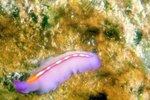
Before the first underwater volcanic ecosystem was discovered, marine biologists believed life always needed light from the sun to survive. These unusual marine habitats proved them wrong. Areas that would otherwise be devoid of warmth, nutrients and life become home to a variety of species when hydrothermal activity is present.
How Underwater Volcanoes Support Life
Underwater volcanoes bring three things into the deep ocean that otherwise wouldn't be there: hot water, minerals and bacteria. When a fissure opens up in the ocean floor, water seeps into it. Bacteria that were living in the earth's crust then take up residence in this hot water, which can reach temperatures of 570 to 750 degrees F. When the fissure erupts and the heated water is expelled, the bacteria go along with it, as well as lots of minerals from rock dissolved by the superheated water. The bacteria are sustained by the warmth from the vent and the minerals, allowing them to multiply. Often the first sign of life around a marine volcano is a thick carpet of bacteria. Once the bacteria develop stable colonies, other deep sea species can use them as food, which are themselves used as food, forming a full food chain.
Species That Thrive Near Marine Volcanoes
Pioneering hydrothermal bacteria provide food for small invertebrates, such as amphipods, shrimp and crabs. The most popular animals and probably the most successful in this environment are the worms. Giant tube worms can grow as much as 3 feet per year, making them the fastest growing invertebrates in the world. Dozens of different worm species populate the vents with great variation of size, color and body plan. Tube worms have red, tulip-like plumes at their tips, while the scale worm (Polychaeta polynoidae) is covered in thin, round, magenta-colored plates on its back. One type of fish is known to lurk around these underwater hotspots -- the slow-moving, always hungry eelpout (genus Thermarces). They're considered to be at the top of the hydrothermal food chain. Hydrothermal octopuses (Vulcanoctopus hydrothermalis) make a close second.
Hydrothermal Animals Depend on Symbiotic Relationships
The bacteria in marine volcano ecosystems do more than provide food for small organisms. They also provide a means of obtaining nutrients for many of the larger species in a symbiotic relationship. In fact, giant tube worms have no digestive systems at all. Instead they are filled with massive colonies of bacteria that synthesize nutrients for them. Many of the worm species around hydrothermal vents have decorative-looking "fur" or "feathers" that are actually colonies of bacteria clinging to them, such as the Pompeii worm (Alvinella pompejana). The shells of hydrothermal mollusks like mussels (Bathymodiolus), limpets (genera Lepetodrilus and Eulepetopsis), clams (Vescomyidae) and barnacles (Neolepas) are also filled with symbiotic bacteria.
A Tentative Existence
Hydrothermal vents are not permanent features within the ocean's geography. Just like geothermal activity on land, volcanoes and vents may be highly active for a short period of time and then suddenly fall silent. According to "Popular Science," researchers have studied cases in which vents and marine volcanoes that were once heavily populated with hydrothermal animals suddenly went dormant. The animals died, and the region became just as dark and barren as the rest of the deep ocean. Populations around marine volcanoes can also be wiped out when magma erupts from the volcano, burning the creatures in its path. However, organisms are able to repopulate the region once the magma has cooled.
References
Resources
Photo Credits
-
Stockbyte/Stockbyte/Getty Images
Writer Bio
Madeline Masters works as a dog walker and professional writer. In the past she has worked as a fitness columnist, fundraising copywriter and news reporter. Masters won two Pennsylvania Newspaper Association Awards in 2009. She graduated from Elizabethtown College with a Bachelor of Arts in English.



